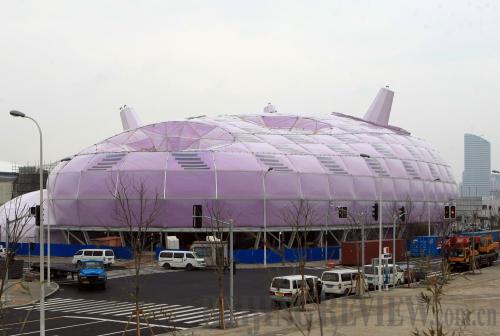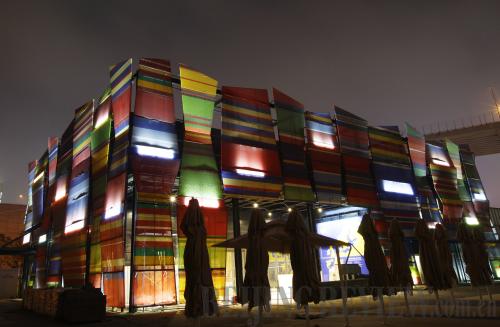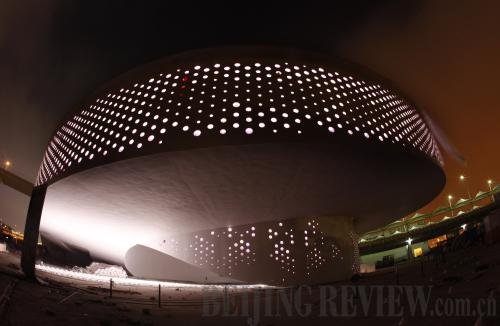|
|


ADVERTISEMENT
Buy Your own advertising
spaces!
.
Download Adobe Acrobat Reader to open [PDF] files.
Recent Visitors
Go Pavilions!
2010. 12 April
 SYMBOL OF FRIENDSHIP: In the shape of a purple cocoon, the Japan Pavilion is designed to symbolize the friendly relations between China and Japan (JIANG XIAOYING)
SYMBOL OF FRIENDSHIP: In the shape of a purple cocoon, the Japan Pavilion is designed to symbolize the friendly relations between China and Japan (JIANG XIAOYING)
by Wang Jun
(bjreview.com.cn)
Scaffolds covered the dome of the India Pavilion, and construction crews were working in the rain on March 30. On the same day, debris was also seen around some of the pavilions for the 2010 World Expo. However, officials for these pavilions are confident that they will open to the public on schedule.
Yang Xiong, Executive Vice Mayor of Shanghai and Deputy Director of the Executive Committee for the 2010 World Expo, shared his confidence and assured reporters at a group interview on March 30 that most of the Expo's pavilions will open as scheduled.
The Shanghai World Expo has made history with the number of participants and pavilions being built. The organizer says that 192 countries and 50 international organizations will participate in the Expo. Participating countries and international organizations have chosen different types of pavilions to showcase themselves. Self-built pavilions are those designed and built by participants on the plot allocated by the Expo organizer, rented pavilions are stand-alone pavilions built by the Expo organizer and rented to participants, while joint pavilions are those constructed by the Expo organizer and offered to developing nations free of charge.
 ILLUMINATED MAKE-UP: The Estonia Pavilion tests its lighting installations on April 5. Many pavilions are at the stage of lighting tests, making the Expo site splendid at night (PEI XIN)
ILLUMINATED MAKE-UP: The Estonia Pavilion tests its lighting installations on April 5. Many pavilions are at the stage of lighting tests, making the Expo site splendid at night (PEI XIN)By December 2009, plans for the Shanghai World Expo included 42 self-built pavilions, 42 rented pavilions and 11 joint pavilions. In addition to this, a number of corporations that are participating in the Shanghai Expo have also opted to build their own pavilions to display their own interpretations of the Expo theme. The Shanghai World Expo will also include 18 corporate pavilions.
Some reports have stated that 10-20 percent of the pavilions would not be finished on time. Yang believes, however, that such reports are erroneous. "I know that every country and organization that is building its own pavilion is doing their best. We still have a month to go, and it is impossible as well as impolite to say how many pavilions will not be finished on time," Yang said.
During a number of previous world expos, approximately 10-20 percent of pavilions had failed to open on schedule. Yang says such a situation will not recur in Shanghai.
"It is predicted that the number of pavilions that do not open on schedule will be much lower than 10 percent of the total," he said. Delays may be caused by late transportation of materials for arranging exhibits, and extended project time because of high standards. "We will all endeavor to reduce the number of pavilions that are unable to open on schedule," Yang told reporters.
The Shanghai World Expo will commence trial operation on April 20 with the participation of approximately 70 percent of the pavilions, Yang said. It is estimated that the Shanghai World Expo, which runs from May 1 to October 31, will draw over 70 million visitors.
In addition to the pavilions, the Shanghai World Expo's permanent constructions, which include the China Pavilion, the Theme Pavilion, the Expo Culture Center, the Expo Center and Expo Boulevard, have all been completed, and construction and installation of supporting facilities within the Expo site are also almost completed. At present, the arrangement of exhibits is progressing smoothly.
 A RADIANT MERMAID: The Denmark Pavilion test-runs its lighting installations on April 5 (PEI XIN)
A RADIANT MERMAID: The Denmark Pavilion test-runs its lighting installations on April 5 (PEI XIN)
Mark Germyn, Chief Operating Officer of the United States Pavilion, told reporters that the construction of the pavilion is at a similar stage of progress to most of the other pavilions, and that the United States Pavilion will participate in the trial operation organized by the Expo on April 20.
Covering an area of 6,000 square meters, the United States Pavilion resembles an eagle, the symbol of America, and has the theme of Rising to the Challenge. "It will focus on lifestyle, health, science and technology and innovation," Germyn said.
He said the pavilion is entirely funded by private enterprises and has a budget of $61.5 million. The United States Pavilion expects 6 million visitors during the Expo, or 35,000 per day.
Australia is also breaking historical records of its own at the Expo, building its biggest pavilion ever. Pavilion Director Peter Sams told the press that the Australia Pavilion would be ready for the Expo even if it were to open tomorrow.
Construction of the Australia Pavilion commenced in January 2009. Australia was one of the first countries to begin construction on the Expo site and, in February 2009, became the first to complete foundation works.
The installation of the pavilion's interior, including the installation of the exhibition content, commenced in September 2009, three months ahead of the organizer's guidelines. The pavilion was completed before March 15, 2010, six weeks prior to the opening of the Expo.
From May 1 to October 31, the visually striking Australia Pavilion will showcase the country's innovation, creativity and achievement for some 7 million visitors—an average of 38,000 people each day during the 184-day expo.
The country's pavilion is one of the most expensive per capita, with a total cost of $76 million. The pavilion will offer dynamic and engaging exhibits, a rich cultural program and a unique selection of retail, food and beverage choices so that visitors are introduced to the sights, sounds and flavors of Australia.
Targeted business promotional events in the pavilion will highlight Australian capability in key industrial sectors, helping to boost trade and two-way investment, and expand institutional and social links.
The Japan Pavilion is in its final, hectic stage of construction, arranging the items on display and performing trial-runs of equipment, said Ehara Noriyoshi, Director of the pavilion. Their target is to complete the pavilion before April 15. During the Expo, the Japan Pavilion is expected to receive a total of 3.5-4 million visitors, or 20,000 per day.
The Japan Pavilion is nicknamed "Purple Silkworm Island." Purple is the color of the Japan Pavilion's exterior. Ehara Noriyoshi says that purple is considered to be an elegant color in both Japan and China. "Silkworm" refers to the exterior of the Japan Pavilion, which evokes a silkworm's cocoon. Silk thread made by silkworms is one of a number of things that symbolize the connections between the cultures of Japan and China. In China, silkworms are also a symbol of immortality, as they are later reborn in a higher and nobler form.
With a total budget of 13 billion Japanese yen, or some $140 million, the Japan Pavilion is divided into three exhibition zones. In Zone One, visitors will see how Japan's culture developed, with a focus upon its interactions with China, through a combination of graphics and video. Zone Two illustrates how Japan's culture focuses on living with the country's abundant natural environment, the dynamism of Japan's cities today, and the newest technologies for solving global environmental problems. Zone Three is a theater that offers 36 shows per day, allowing visitors to see some of the latest technologies developed in Japan, such as the "wonder camera" and violin-playing robot.
The India Pavilion will be finished by April 15 and participate in the trial-run organized by the Expo on April 20, said Rajesh Kumar, organizing team director of the India Pavilion. Although the pavilion was still covered with scaffolds on March 30, Kumar is confident his team can finish all the work necessary on schedule, and the pavilion will be opened to the public prior to May 1 as scheduled.
Better City, Better Life is the theme of the Expo, and India has taken this theme a few steps further: Cities of Harmony is the concept that will be promoted by the India Pavilion. In order to promote the theme of Cities of Harmony, the displays of the India Pavilion will consist of a cultural, social, scientific, technological and geographical matrix.
The pavilion, with a total budget of $20 million, consists of two synergized sections: an entry plaza and a main dome. The theme of India's diversity will be started at the plaza through live cultural stage performances, foods and handicrafts. The theme of achieving Cities of Harmony, with the maxim that As We Reap, So We Should Sow, will be developed in the central dome, which is the largest bamboo dome in the world.
The India Pavilion is a zero-chemicals area with safe runoff and no effluents. It uses plants to recycle water for the greenery and employs rainfall harvesting to ensure water supply during periods of little rain, said Kumar.
Only a few steps away from the China Pavilion, the Hong Kong Pavilion is also in the final stage of exhibition arrangement, said Chan Chi-king, Commissioner of the Expo Affairs Office of the Hong Kong Special Administrative Region. The pavilion will also participate in the trial-run operation on April 20.
With a total budget of HK$145 million ($19 million), the Hong Kong Pavilion covers an area of 637 square meters and conservative estimates are that the pavilion will receive 7,000-8,000 visitors a day during the Expo.
The metallic, three-story Hong Kong Pavilion displays the theme of Hong Kong—Potential Unlimited, which features the region's unique connectivity with the Chinese mainland and the world in terms of both hardware and software. The pavilion will highlight Hong Kong's achievements in sustainable urbanization and illustrate the infinite potential for enhancing city life in a place with limited land resources.
Six elements will be highlighted: excellent infrastructure and connectivity with the Chinese mainland and the world, well-connected and highly efficient domestic transportation networks and services, advanced and seamless information technology and telecommunication infrastructure, free flow of money, goods and information serving the Chinese mainland and the world, cultural diversity, harmony and creativity as well as sustainable high-quality city life.
Source: bjreview.com.cn

